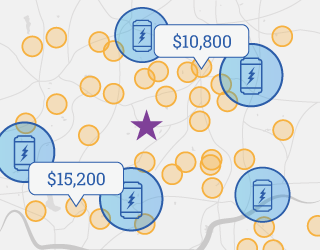The Tesla ecosystem is full of innovative energy products, from cars to solar roof tiles and more. One of Tesla’s lesser-known offerings is the Powerpack, a commercial-scale battery storage system designed to help large electricity users save money and control their energy usage.
Key takeaways
- The Tesla Powerpack is an energy storage solution for commercial and industrial customers
- It’s already in use, too – South Australia relies on a battery plant built with Powerpacks to provide grid stability
- Residential customers can benefit from energy storage as well – register on the EnergySage Marketplace to start comparing quotes for free
What is the Tesla Powerpack?
The Tesla Powerpack is a scalable, commercial-scale battery storage solution that can be used to store electricity to be dispatched at a later time. Tesla has long been involved in the energy business, and with their acquisition of SolarCity in 2016, they solidified their investment in solar and battery storage. The Tesla Powerwall is a residential energy storage solution, and is one of the most popular home energy storage options available.
How much energy can the Powerpack store?
One Powerpack can store up to 232 kilowatt-hours (kWh) of electricity, and the product is scalable, meaning you can stack multiple Powerpacks together to store even more energy. That’s more than seventeen times larger than the residential-sized Powerwall battery!
How much even is 232 kWh of electricity? According to the U.S. Energy Information Administration (EIA), an average commercial property’s electricity usage is a little over 6,000 kWh per month. This means that, roughly, a Powerpack can store enough electricity to keep an average business up and powered for over a day.
PowerPack vs. Megapack vs. Powerwall
Tesla makes three energy storage products: the Powerwall, the Powerpack, and the Megapack. These products are made for residential, commercial, and utility-scale customers, respectively. The Powerwall is a completely different product from the Powerpack and Megapack, as it is intended for residential use, functioning like most solar battery options available. The Powerpack and Megapack are actually somewhat similar products, just scaled differently.
If you’re shopping for solar-plus-storage for your home, don’t worry about anything except the Powerwall – anything bigger is for large commercial properties and utility companies.
What is the Powerpack used for?
There are several reasons a commercial electricity consumer might want to install a product like the Tesla Powerpack – most of which center around financial savings. Two primary benefits of a system like the Powerpack are what’s known as “load shifting” and “peak shaving”.
Load shifting is the practice of using stored electricity during times of overall high electricity demand on the grid. By using stored electricity from a battery like the Powerpack, a business doesn’t need to pull as much from the grid, which means they don’t have to pay for their electricity in that exact moment. This is important because in many places around the country, electricity costs more during those high demand times.
Peak shaving is a similar concept to load shifting in that it is a way to use stored electricity from a system like the Powerpack to avoid paying high energy prices. Peak shaving is a specific tool to mitigate what are known as demand charges, which are more commonly used with commercial and industrial electricity users than residential properties.
If your utility uses demand charges, they will charge you not just based on how much electricity you consume over the course of the month, but also how much electricity you use in one (usually 15-minute) period. This extra charge incentivizes commercial and industrial electricity users to spread out energy usage as much as possible to keep that extra charge low.
With a system like the Tesla Powerpack, a commercial building could avoid an extra high demand charge by drawing some electricity from their battery system during those times of high need.
The Tesla Powerpack in the news
Tesla made headlines a few years back when they won a bid to build what was, at the time, the world’s largest lithium-ion battery: the system was a 129 megawatt-hours (MWh) build when it went live in 2017. Believe it or not, the actual batteries used to the system, known as the Hornsdale Power Reserve (and known perhaps more familiarly as the “Tesla big battery”), were Powerpacks. In 2020, the storage system was expanded up to 194 MWh of capacity.
It’s estimated that the Hornsdale Power Reserve saved $116 million in grid costs during the full year of 2019, mostly from its role in the power control market keeping electricity prices low.
Find your ideal solar-plus-storage system on EnergySage
For most solar shoppers, the Tesla Powerpack is not the right storage solution. You’re much better off as a homeowner going with a home battery like the Tesla Powerwall or sonnen eco. Finding the right storage system for your home means comparing multiple quotes from solar installers. Using the EnergySage Marketplace, you can find local solar installers near you, and make easy side-by-side comparisons of all your solar-plus-storage options, including equipment. By shopping around first, you can find the right option at the right price – warranties and all.






